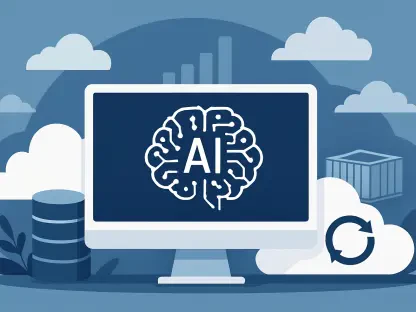The rise of artificial intelligence is reshaping the landscape of data centers and enterprise computing. As AI workloads increase, companies face the urgent need to adapt their IT infrastructure to stay competitive. This article explores these changes and provides insights from industry experts on how to navigate this critical transition. Traditional IT infrastructures are inadequately equipped to handle the complex and resource-intensive demands of AI. Therefore, a comprehensive transformation of data centers is imperative. Businesses must now shift their focus from conventional computing methods to AI-driven solutions to remain at the forefront of innovation. This evolution represents a significant leap forward, aimed at meeting the stringent demands posed by AI workloads, which require advanced computing abilities and unparalleled agility.
As AI workloads demand more from data centers than traditional computing, organizations need to reassess their current strategies and adopt new approaches that can support these evolving requirements. With predictions indicating AI-driven computing will dominate nearly 90% of data center spending in the next decade, the urgency of this shift becomes unmistakable. Enterprises that successfully align their infrastructure with this new computing era will harness the full potential of AI, driving innovation, efficiency, and competitive advantage. The transformation necessitates investments in advanced technologies, reimagined processes, and skilled personnel, ensuring seamless integration of AI systems. Ultimately, the transition invites businesses to embrace a future where AI plays a central role in driving progress and optimizing operations.
AI’s Impact on Data Centers
Artificial intelligence is revolutionizing the data center industry, fundamentally reshaping IT strategies and architectures. Predictions indicate that AI-driven computing will dominate nearly 90% of data center spending within the next decade, marking the beginning of a new era characterized by extreme parallel computing and accelerated processing capabilities. This shift forces enterprises to rethink their infrastructure, moving away from traditional methodologies that may not sufficiently support these complex and demanding AI workloads.
Furthermore, AI workloads require significantly more from data centers compared to traditional computing setups. The resource-intensive nature of AI tasks leads to higher computational demands, data throughput, and storage requirements. As traditional infrastructures fall short of meeting these needs, companies must implement comprehensive transformations to remain competitive. AI-driven tasks push the boundaries of current technological capacities, compelling businesses to adopt cutting-edge solutions and rethink their operational strategies to ensure optimal performance and innovation. By leveraging advanced systems and methodologies, organizations can achieve unprecedented levels of efficiency and agility.
This transformation is not merely about upgrading existing systems but calls for a fundamental overhaul of data center design and functioning. Enterprises need to incorporate advanced technologies such as high-performance computing (HPC), robust cooling systems, and accelerated processing units to handle AI workloads effectively. Such modifications are pivotal in ensuring that data centers can sustain the increased demands of AI while maintaining operational efficiency and cost-effectiveness. By strategically deploying these solutions, businesses not only meet current AI requirements but also establish a forward-looking infrastructure capable of scaling with evolving technological trends.
Challenges in AI Adoption
Organizations face several significant challenges when integrating artificial intelligence into their existing systems. One of the most prominent hurdles is the persistent skills gap, which leaves many enterprises lacking the expertise needed to develop, manage, and optimize AI infrastructure. Traditional IT setups were not designed to support AI’s unique requirements, including processing power, data management, and storage needs, thus demanding a complete rethink of the current approach. This educational void makes it difficult for businesses to fully leverage AI’s potential, hindering their ability to innovate and compete effectively.
Additionally, underutilized GPU clusters represent another challenge that enterprises encounter during AI adoption. Many organizations invest in high-capacity GPU systems to support AI workloads; however, these clusters are often not used to their full potential due to inefficient resource management or lack of AI-specific strategies. Ensuring that these GPUs are harnessed effectively requires a clear understanding of AI processing needs and the ability to design and implement systems that can optimize their use. Addressing these inefficiencies is crucial for maximizing the returns on investments in AI infrastructure and ensuring smooth integration of these advanced technologies.
Beyond technical and operational hurdles, integrating AI into existing systems involves navigating the complexity of melding AI solutions with traditional IT infrastructures. Successful AI adoption necessitates a holistic approach that encompasses both the technical aspects and the strategic alignment of AI with the organization’s broader objectives. Enterprises must consider various factors including data center architecture, cooling solutions, network technologies, and AI-specific hardware to build efficient and scalable AI environments. Expert guidance and strategic planning play pivotal roles in this integration process, helping companies avoid costly missteps and ensure effective adoption of AI technologies.
Building AI Infrastructure
Successfully building AI infrastructure in-house requires a strategic approach tailored to meet specific organizational demands. Enterprises face critical architectural decisions, including the choice between different cooling methods such as liquid cooling, direct-to-chip cooling, or air cooling. These decisions, while technical, significantly impact the performance, efficiency, and sustainability of AI infrastructure. Choosing the right cooling solution is integral to maintaining the optimum operational environment for AI systems, ensuring effective temperature management, and maximizing hardware lifespan.
Besides cooling solutions, selecting the best combination of chip vendors, storage solutions, and networking technologies is crucial in building a robust AI infrastructure. Each component must align with the specific needs of AI workloads, offering enhanced performance, speed, and reliability. Enterprises frequently seek expert insights and guidance to navigate these decisions, aiming to design scalable and efficient AI environments. Expert advice helps mitigate risks and avoid costly missteps that can derail AI projects, providing a solid foundation for successful AI integration.
Building AI infrastructure also involves considering the scalability and future-proofing of the systems in place. Technology advancements and increasing AI demands necessitate infrastructures that can grow and adapt over time. Strategic planning and implementation focus on creating modular, flexible systems capable of scaling with the evolving landscape of AI. This foresight ensures that enterprises are not only meeting current requirements but are well-positioned to accommodate future advancements and increased workload demands efficiently. Thoughtful architectural design and expert guidance are pivotal to achieving a sustainable and competitive AI infrastructure.
Performance and Resilience
AI infrastructure demands optimization for peak performance and resilience, diverging significantly from traditional setups that primarily focus on uptime and availability. Managing GPU clusters, which can frequently fail under continuous high-capacity operation, presents a significant challenge to maintaining the resilience and reliability of AI systems. Enterprises must implement intelligent compute environments capable of balancing workloads effectively, ensuring that GPU clusters operate optimally and reduce the likelihood of failures.
Implementing predictive failure analysis tools plays a crucial role in maintaining the performance and resilience of AI infrastructure. These advanced tools help identify potential issues before they result in failures, allowing preemptive actions to be taken. Predictive analysis enables organizations to manage their systems proactively, minimizing downtime and ensuring consistent operational efficiency. The ability to anticipate and address problems before they escalate is indispensable in preserving the reliability and performance of AI systems, safeguarding against disruptions and optimizing resource utilization.
Optimization of AI infrastructure also extends to adapting strategies that ensure sustained performance levels. Enterprises need to adopt methodologies that account for the high demands of AI workloads, using intelligent compute practices that dynamically allocate resources and manage operations efficiently. This strategic approach ensures that AI systems can handle complex tasks seamlessly, maintaining peak performance across varied applications. The integration of advanced monitoring, management, and predictive tools contributes to an AI infrastructure that excels in resilience and functional stability, fostering an environment conducive to innovation and growth.
Addressing the AI Skills Gap
Bridging the persistent AI skills gap is essential for building sustainable and competitive AI infrastructures. Developing AI systems requires a unique blend of traditional IT knowledge and high-performance computing expertise, which many organizations presently lack. This skills deficiency poses a significant barrier to effective AI adoption, impacting the ability of enterprises to fully leverage AI technologies and integrate them seamlessly into existing operational frameworks. Addressing this gap is crucial for ensuring that businesses can harness the full potential of AI to drive innovation and competitive advantage.
Investment in training programs tailored to AI-specific needs is a vital step toward overcoming the skills gap. Organizations must prioritize educating their workforce about the intricacies of AI technologies, focusing on both theoretical and practical aspects. Collaboration with AI-focused technology partners can provide valuable insights and hands-on experience, enhancing the proficiency of in-house teams. These collaborative efforts not only mitigate the lack of specialized AI knowledge but also foster a learning environment conducive to continuous improvement and adaptation to evolving AI trends.
Moreover, developing a sustainable AI infrastructure goes beyond immediate training initiatives. It involves strategic long-term planning aimed at cultivating a culture that embraces AI advancements and encourages ongoing skills development. Establishing partnerships with educational institutions, participating in AI-focused conferences, and promoting research and development are critical measures to ensure the workforce remains up-to-date with the latest AI methodologies and practices. These initiatives collectively contribute to building a robust foundation for AI adoption, empowering organizations to create and maintain competitive AI environments that drive innovation and sustainable growth.
Transformation Driven by AI
Artificial intelligence is catalyzing a profound transformation across the data center industry, necessitating new infrastructure rules and strategies to support AI-driven computing. The consensus among industry experts highlights the urgency of this shift, predicting that AI will substantially dominate data center spending. Enterprises must embrace new approaches that align with AI’s unique requirements, fundamentally rethinking and redesigning their IT setups to leverage the full competitive advantage offered by AI technologies.
This transformation demands a holistic reevaluation of traditional methodologies, incorporating advanced systems and practices tailored to AI needs. Organizations must focus on creating infrastructures capable of handling the stringent demands of AI workloads, ensuring scalability, efficiency, and resilience. Adopting new strategies includes investing in cutting-edge technologies, reimagining operational processes, and cultivating a skilled workforce adept at managing AI systems. This comprehensive approach is essential for achieving sustained success and innovation in an AI-driven landscape.
As AI continues to reshape the industry, the ability to adapt and evolve becomes a critical factor for enterprises aiming to remain competitive. Embracing AI-driven transformation invites businesses to explore innovative solutions that enhance performance, optimize operations, and drive growth. Strategic planning and thoughtful implementation are pivotal in navigating this transition, ensuring that organizations can harness AI’s full potential. By redefining IT setups and infrastructure strategies, enterprises position themselves at the forefront of technological advancement, paving the way for a future where AI plays a central role in driving progress and efficiency.
Integration Complexity
Integrating AI into existing systems is inherently complex, involving a fundamental overhaul of traditional IT setups. AI solutions necessitate a comprehensive approach that considers multiple aspects, including data center architecture, cooling solutions, network technologies, and AI-specific hardware. Organizations must navigate this complexity, ensuring that each element harmonizes to create a cohesive and efficient AI infrastructure capable of meeting the unique demands of AI workloads.
Modular infrastructure solutions play a crucial role in addressing the integration complexity. These solutions offer the flexibility and scalability needed to adapt to various AI requirements, allowing enterprises to build environments that can grow and evolve with technological advancements. Modular systems enable businesses to implement changes incrementally, minimizing disruptions and ensuring smooth integration processes. Expert guidance is essential in designing and deploying these solutions, helping companies avoid pitfalls and optimize their AI strategies effectively.
The transition to AI also involves strategic planning to align AI capabilities with broader organizational objectives. Successful integration requires a careful assessment of existing systems, identifying areas that need modification or enhancement to support AI technologies. This strategic alignment ensures that AI solutions are not only technically sound but also contribute to achieving the enterprise’s goals. By addressing integration complexity thoughtfully and methodically, organizations can build scalable AI environments that enhance operational efficiency, drive innovation, and maintain competitive advantage.
Optimizing Performance
Optimizing AI infrastructure for peak performance and resilience remains a priority for enterprises aiming to leverage AI technologies effectively. Intelligent compute environments and predictive failure analysis tools are indispensable for managing the high demands of AI workloads, ensuring that GPU clusters perform reliably and efficiently. These tools enable organizations to proactively address potential issues, minimizing downtime and maintaining consistent operational efficiency.
Performance optimization extends to adopting dynamic resource allocation strategies that balance workloads effectively across AI systems. This approach ensures that AI infrastructure can handle complex tasks seamlessly, maintaining peak performance levels across varied applications. Organizations must implement advanced monitoring and management practices that facilitate real-time adjustments, optimizing resource utilization and operational stability. Such practices contribute to an AI infrastructure that excels in resilience, fostering an environment conducive to innovation and growth.
Moreover, optimizing AI performance involves continuous evaluation and refinement of existing systems. Enterprises need to stay abreast of technological advancements and evolving AI methodologies, adapting their strategies to maintain competitive edge. Regular assessments and updates ensure that AI infrastructure remains aligned with current demands and future requirements, providing a solid foundation for sustained success. By prioritizing optimization, organizations can harness the full potential of AI, driving progress and efficiency while safeguarding against disruptions and inefficiencies.
Bridging the Skills Gap
The rise of artificial intelligence (AI) is transforming data centers and enterprise computing. As AI workloads grow, businesses must quickly adapt their IT infrastructure to stay competitive. This article examines these changes and offers insights from industry experts on navigating this critical transition. Traditional IT setups fall short of addressing the complex, resource-intensive demands of AI. Therefore, a comprehensive overhaul of data centers is essential. Businesses need to transition from conventional computing to AI-driven solutions to stay innovative. This shift is crucial to meet the stringent requirements of AI workloads, which need advanced computing power and exceptional agility.
As AI demands more from data centers than traditional computing, organizations must reassess their strategies and adopt new approaches to support these evolving needs. With predictions that AI-driven computing will dominate 90% of data center spending in the next decade, the urgency of this shift is clear. Companies that successfully update their infrastructure for this new era will leverage AI’s full potential, driving innovation, efficiency, and competitive advantage. This transformation requires investments in advanced technologies, redefined processes, and skilled personnel. Ultimately, businesses are invited to embrace a future where AI is central to progress and optimized operations.









